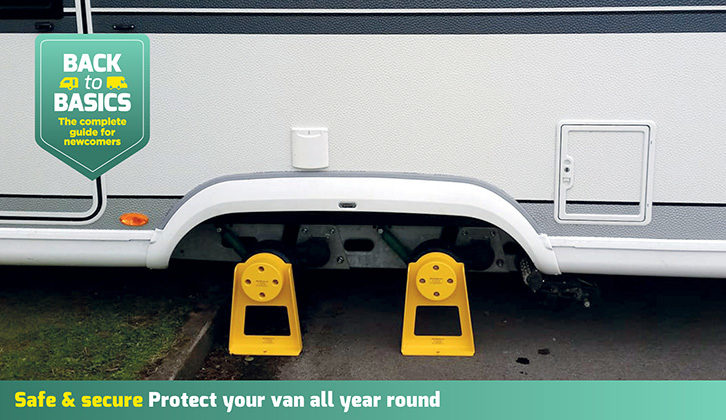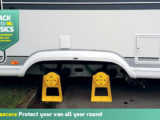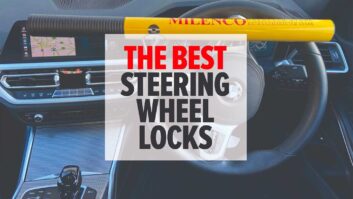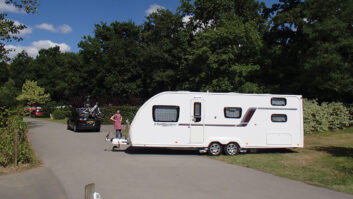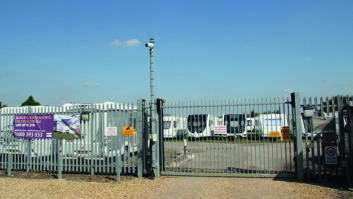Although the chances your caravan will be stolen or broken into are small, the number of these unwelcome incidents has been growing; so there’s never been a better time to audit your security provisions, and check they are as good as they can be.
Caravan thieves are unbelievably brazen – if you’re thinking, “My van’s parked six feet from my house – nobody will touch it”, you really need to think again.
Any security is better than none, but an experienced thief can remove a budget lock in seconds, so it pays to buy wisely. Follow our guide to the top 10 security measures for your caravan, and you’ll be making life as difficult as possible for them.
1 Wheel locks
How many times have you heard the old adage, “You get what you pay for”? Well, it’s generally true, and never more so than when buying caravan security.
Wheel locks come in all shapes and sizes, but the one the insurance companies seem to favour is the Al-Ko Secure wheel lock. This device is smaller and lighter than most other wheel locks, so it’s easier to transport. The receiver is also fixed to the caravan’s chassis, making it a more secure option.
When fitted, the lock receiver is visible behind the wheel and the device slides between the wheel ‘spokes’ before the bolt is screwed into the receiver.
Start by aligning the wheel so that the receiver is visible and centred between two spokes. Take out the yellow plug, which caps off the receiver when it’s not in use.
The lock has several parts. Position the main red lozenge between the spokes so the hole in it aligns with the receiver. Now push the threaded bar through and use the extension bar to screw it into the receiver, first finger-tight, then using a wrench to tighten it further. Finally, remove the extension bar, and push the locking barrel into the hole and lock it in place.
Some caravans are sold with the entire locking mechanism supplied, but many just come with the receiver, and you have to buy the locking mechanism yourself.
- Al-Ko locks can be retrofitted, depending on your caravan’s backplate. Check out the ‘Will it fit?’ section on www.al-ko-secure.co.uk to see if your caravan is compatible. The red Al-Ko inserts are designed to fit specific spoke patterns (shown by the number on the faceplate), so you’ll need to know which fitment you have before you buy.
Finally, ensure you register your wheel lock with Al-Ko; otherwise, if you lose your keys, it could cost you a small fortune to call out a technician to remove the lock.
Take a look at our best caravan wheel lock guide for more suggestions.
Other options
A wide range of wheel locks is available, from brands such as Milenco, Bulldog, Maypole and Fullstop. These don’t require a prefitted receiver, are often cheaper, and if you have a twin-axle, are much easier to fit – aligning two wheels to the perfect spoke position can be quite tricky with an Al-Ko Secure lock.
Most tend to clamp around the wheel in a similar fashion, to prevent the caravan being towed. These clamps are generally a lot bigger, and will require storage space in an external locker. Some of them can also be rather awkward to fit.
- Take a look at our best caravan wheel lock guide, where we share our top picks on the market
2 Hitchlocks
The best caravan hitchlock will be a compact and fairly lightweight security device, and like a wheel lock, is considered the bare minimum provision by many insurance companies.
A hitchlock clamps and locks securely around the hitch-head, preventing a towball from being inserted into the hitch. They are quick and simple to fit, and easy to store in a front locker, so they’re always on hand.
Along with a hitchlock it’s also advisable to fit a wheel lock where it’s highly visible, on the off side of the caravan. In fact, the more deterrents, the better.
Professional thieves have been known to remove hitchlocks with an angle-grinder or even an oxy-acetylene torch, but a hitchlock is a great deterrent and will put off the vast majority of opportunist thieves, who would rather focus on the caravan that has no security devices.
Note Not having a wheel lock and hitchlock fitted at all times when your van is unhitched may invalidate your insurance.
3 Storage facilities
Most caravans are stolen, vandalised or broken into when they’re being stored, rather than while they’re in use – and the vast majority of them are taken when they are stored at your home.
Using online map apps, a thief can zoom in on a suburb or estate and pick out a good half-dozen potential victims in a matter of seconds. Our gleaming white tourers stand out like
the proverbial sore thumb!
According to insurance company figures (premiums are based almost entirely on probability), 57% of stolen tourers are taken from outside the home, while just 3% are stolen from secure storage facilities.
This vast difference is reflected in the discounts available – some insurers offer up to 25% lower premiums if you store your van in a professionally run, secure facility.
Many people keep their caravan at farms or similarly remote locations when they’re not in use. These tend to be cheap, but their remoteness is the only defence.
The problem is, some places are so secluded that a thief who does discover a caravan in storage there has all the time in the world to defeat any security.
There are some amazing videos to be found online, showing teams of thieves using grinders and gas-torches to remove numerous devices from a caravan, and all at an extremely leisurely pace.
For ultimate levels of security, you should consider using a facility registered with the Caravan Storage Site Owners’ Association (CaSSOA), and in particular, one that has been rated Silver, Gold or Platinum.
In fact, CaSSOA’s Platinum rating is a whole new level of security for 2021 – think Fort Knox for caravans. The first location to achieve it is Border Caravan Storage, in south Lincolnshire. I know the place well: private location, staff on site all year round, palisade fencing, alarm-activated lights, CCTV, air-lock exit and entry gates operated
by key fob, digital tagging on every vehicle, vans perfectly spaced apart, no overhanging trees or branches and no weeds growing around units stored there. It certainly feels extremely secure.
And that’s the point – professional storage facilities trade on their security and their reputation, so the best ones will always go the extra mile for customers.
Annual storage costs will vary, depending on where in the country you’re located, but as an example, they range from about £200 to around £600 in the south-east.
Check out the sites at cassoa.co.uk; but you should also bear in mind that there are also some great facilities which aren’t registered with CaSSOA.
4 Winter wheels
I’ve been told by those ‘in the know’ that winter wheels are by far the single best physical security device for tourers kept in long-term storage or on an annual pitch.
This is easy to believe, but gaining that additional peace of mind does involve a bit of hassle. Winter wheels are not actually wheels at all; rather, they are axle stands, which bolt onto the wheel hub in place of a removed wheel. A potential thief would have to be very motivated indeed to arrive at your van with replacement wheels, then try to burn off the device with oxy-acetylene, and hope the heat doesn’t damage and seize the hub. Pop your wheels in storage – away from the caravan, obviously – and your tyres will also benefit from not sitting for three to six months under the weight of the van.
Several companies make winter wheels, including JSB Hublock, Fullstop Security and Safe & Secure. Prices range from about £75 to £180, although the more expensive package does include locking wheel bolts.
Visit the websites and watch the YouTube videos before making your buying decision, but rest assured that winter wheels offer great security for stored vehicles.
5 CCTV
CCTV has become far more affordable in recent years, and many systems only require a power supply – they do not need hardwiring into a video feed with cables running all around your property.
Cleverly, the latest designs also link easily to your home Wi-Fi, and the footage can be stored on a hard drive or in the cloud. Fit the cameras out of reach or out of view, overlooking your caravan.
Systems are available from well under £100, but generally, the more you pay, the better the camera will be. Google Nest offers a camera for £99, but check out other brands too, such as Yale and Ring.
You might not require the highest HD resolution available, but your camera should record in sufficient quality for faces and registration numbers to be defined.
If your CCTV records images beyond your property’s boundaries, you must use your system in line with data protection laws. You are not breaking the law, but you do become a ‘data controller’, as defined in the UK General Data Protection Regulation. However, in all but the smallest number of instances, this should not be a problem.
6 Alarms
Alarm systems are another excellent deterrent, especially once they have been triggered, because the thieves will then be under significant pressure to vacate the premises, or silence the alarm, as quickly as they possibly can.
Factory-fitted alarms tend to be positioned in the same location on a caravan, so experienced thieves might know where they are if they decide to attack and silence them.
If you are having an aftermarket alarm fitted, ensure that the control box and siren are hidden away. The opportunist thief will almost certainly leg it if an alarm sounds, but the brazen professional is more likely to come prepared.
There are many budget systems available, but we’d suggest going for a specialist brand, such as Moving Intelligence or Outsmart the Thief.
7 Trackers
Buy wisely and you’ll find the latest tracker systems are very effective. The best are part of an integrated alarm and tracker set-up, so if your caravan is broken into, or moved, tilted or lifted, while the alarm is set, a suite of defences is triggered.
The alarm will sound immediately and the system will contact the security firm’s tracking centre. They will then call you to find out if the system has been triggered accidentally, or if the caravan is actually being attacked or stolen. All this happens within a minute. After this, the local police can be contacted if required.
In theory, a stolen caravan can be tracked across almost all of the UK. In fact, a few years ago, for the purposes of an article that I was writing, I faked a caravan ‘theft’ in rural Lincolnshire.
The tracker company did not know when I would ‘steal’ the caravan and trigger the system, but as I raised the hitch-head to put it on a towbar, the alarm sounded and seconds later the ‘owner’ got a call.
I towed the van off into the wilds, and the owner set off in pursuit from a location just a few miles away. I eventually parked the ‘stolen’ caravan in an isolated lane, but within minutes the owner, being guided by the tracking station, found us.
Of course, this wasn’t a real-life scenario – we would certainly never recommend that owners confront thieves – but it did very clearly illustrate how effective and accurate these systems are. In this particular case, we were using a tracker from Outsmart the Thief.
There are other reports of stolen vans being put into shipping containers and sent abroad. Inside the container, the signal was not effective, but as soon as the van was removed, in New Zealand for example, it reappeared on the tracking screen!
Vehicle trackers are available in various guises, including app-based ones that will contact your mobile (these require a SIM card, provided by the supplier), which start at around £200, and full-on systems with staffed tracking centres, from about £500.
Phantom trackers cost from £699 for its Sentinel 7 system, while Outsmart the Thief set-ups start at £688. Remember that most trackers will also require the payment of a lifetime or annual subscription.
8 Steady locks
Quick and easy to use and store, these simple locks increase the hassle level for any would-be thief, simply by locking the corner steadies in the lowered position, making it impossible to tow the caravan.
Among the many brands of lock available, Milenco, for example, has a twin-pack with hardened-steel locks for £48.95.
9 CRiS
CRiS, the Central Registration & Identification Scheme run by the NCC, is a database listing all UK-manufactured (and some imported) caravans and their registered keepers – rather like a DVLA for caravan owners.
Every caravan window is etched with the van’s unique VIN number, as is the chassis. This makes it easy to identify stolen vans, and impossibly expensive for a thief to hide the caravan’s real identity. Always check that your caravan has visible and matching CRiS numbers when buying.
Since the 2016 model year, an updated VIN/chip system has been introduced, with tamper-evident window stickers replacing the etching. A master sticker located on the window by the door features a QR code, which can be read by any smartphone with a scanning app.
Once the code has been scanned, the phone logs on to the CRiS database and reveals the caravan’s details, including layout and spec. Obviously, if this data doesn’t match the tourer you’re looking at, something is amiss.
10 Security posts
Security posts are a cheap and relatively effective defence or deterrent against ‘tow-away’ thefts for caravans stored at home. Position your van on your drive and lock the post in position behind it. They’re very quick to use, although the professional thief can also remove them pretty rapidly. But again, as a deterrent, they might convince an opportunist thief
to move on and try elsewhere.
Security posts tend to come in bolt-down or concrete-in designs, the initial option being easier to fit, but arguably less secure. Prices start from around £50.
Sold Secure
You’ll likely see ‘Sold Secure’ branding on various security products when looking to purchase. Sold Secure tests and certifies these items, working closely with insurers, business, the police, the Home Office and the public in its efforts to raise standards by highlighting the best products.
Security device manufacturers pay to have their products tested and certified by the organisation. Visit the Sold Secure website (www.soldsecure.com) for more info.
Summary
There is another well-known saying, that you never prevent a caravan theft, you just displace it. This is a sad fact of life, and it is every caravanner’s responsibility to make it as difficult as possible for a thief to steal their much-loved caravan.
No caravan security device is infallible, and given time, most physical apparatus can be overcome by the determined thief. But the crucial word here is ‘time’.
Fitting a number of security devices will slow the thieves down, making your caravan a much less attractive option for them, which is why it is a good idea to fit high-visibility products.
For your peace of mind, to minimise the hassle of sorting out a claim and, ultimately, to benefit your pocket, it’s time to make your home-from-home as safe as houses.
If you want some more great tips to keep your caravan safe, be sure to head to our Back to Basics: Safe & Secure category.
Future Publishing Limited, the publisher of practicalcaravan.com, provides the information in this article in good faith and makes no representation as to its completeness or accuracy. Individuals carrying out the instructions do so at their own risk and must exercise their independent judgement in determining the appropriateness of the advice to their circumstances. Individuals should take appropriate safety precautions and be aware of the risk of electrocution when dealing with electrical products. To the fullest extent permitted by law, neither Future nor its employees or agents shall have any liability in connection with the use of this information. You should check that any van warranty will not be affected before proceeding with DIY projects.
Looking for a cover for your van? Our guide to the best caravan covers will help you choose the ideal one for you.
If you’ve enjoyed reading this article, why not get the latest news, reviews and features delivered direct to your door or inbox every month. Take advantage of our brilliant Practical Caravan magazine SUBSCRIBERS’ OFFER and SIGN UP TO OUR NEWSLETTER for regular weekly updates on all things caravan related.
